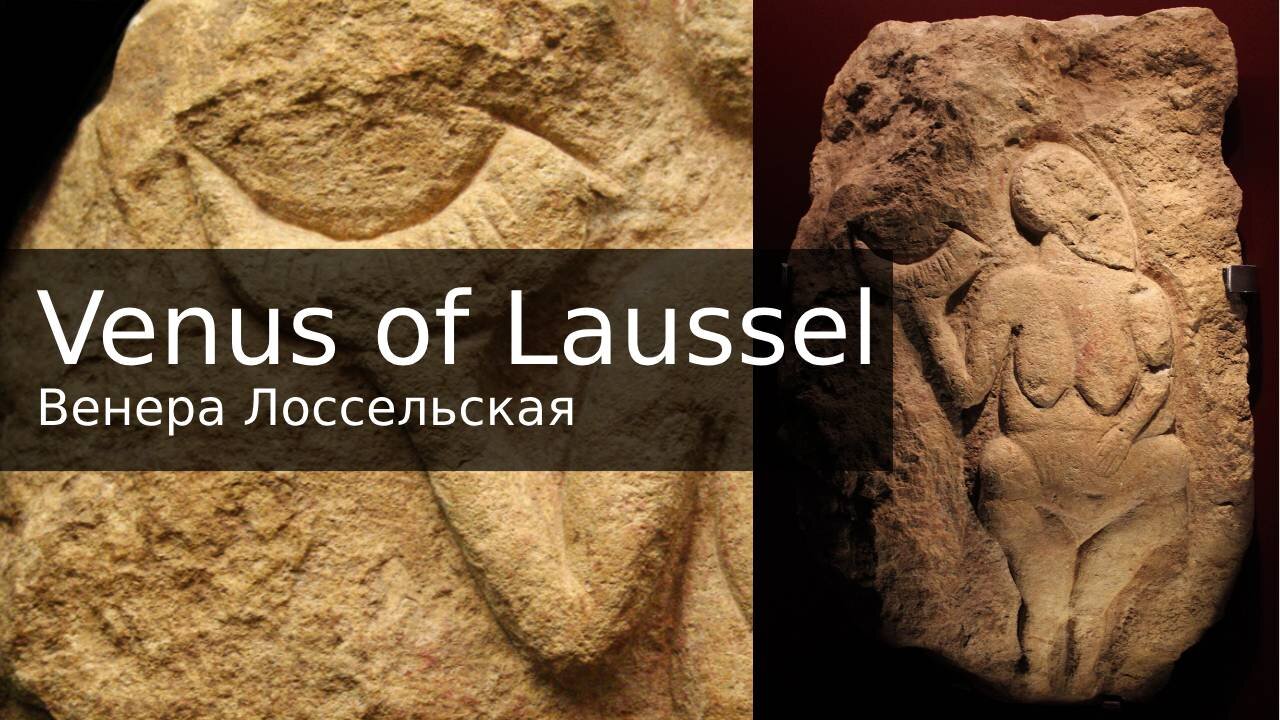Premium Only Content

Венера Лоссельская /Venus of Laussel #zhorzhetta82 #olgadzhus
Станьте спонсором цього каналу, щоб отримувати бонуси:
https://www.youtube.com/channel/UCHJbcIihXPmdjBLREb_21-A/join
#volo_kot #olgadzhus #zhorzhetta82
The Venus of Laussel is an 18.11-inch-high (46.0-centimetre) limestone bas-relief of a nude woman. It is painted with red ochre and was carved into the limestone of a rock shelter (Abri de Laussel) in the commune of Marquay, in the Dordogne department of south-western France. The carving is associated with the Gravettian Upper Paleolithic culture (approximately 25,000 years old). It is currently displayed in the Musée d'Aquitaine in Bordeaux, France.
The figure holds a bison horn, or possibly a cornucopia, in one hand, which has thirteen notches. She has large breasts, a great stomach, and wide hips. There is a "Y" on her thigh and her faceless head is turned toward the horn. The lower relief was covered in red ochre.[1]
The relief was discovered in 1911 by Jean-Gaston Lalanne, a physician. It was carved into large block of limestone in a rock shelter (abri de Laussel) at the commune of Marquay in the Dordogne department of south-western France. The limestone block fell off the wall of the shelter. It was brought to the Musée d'Aquitaine in Bordeaux, France.
The figure and the horn are considered significant in figurative studies of Paleolithic art. There are many similarly formed "goddess figures", such as Venus of Willendorf, said to be of potential significance in Eurasian prehistoric religion.[2][3][4][5] The color and the number of notches on the horn may symbolize the number of moons or the number of menstrual cycles in one year, or the number of days from menstruation to ovulation
Венера Лоссельская — вапняковий барельєф із зображенням оголеної жінки заввишки 6,0 сантиметрів). Він намальований червоною охрою і був висічений у вапняку скельного укриття (Абрі де Лоссель) у комуні Марке, департамент Дордонь на південному заході Франції. Різьблення пов'язане з граветською культурою верхнього палеоліту (приблизно 25 000 років). В даний час він експонується в Музеї Аквітанії в Бордо, Франція.
В одній руці фігура тримає ріг бізона або, можливо, ріг достатку, який має тринадцять насічок. У неї великі груди, великий живіт і широкі стегна. На її стегні є буква «Y», а безлика голова повернута до рогу.
Венера Лоссельська є рідкісним прикладом доісторичного барельєфу.
Вважається, що такі скульптури – символ родючості. Але не все так просто.
Жителі льодовикового періоду не залежали від родючості землі, а дітей народжували зовсім мало: на відміну від хліборобів, мисливці-збирачі не могли прогодувати велику родину. Крім того, у кочівників палеоліту не могло бути маленьких дітей більше, ніж дорослих, які могли нести їх на руках, ми пам'ятаємо, що ні в'ючної худоби, ні тим більше возів у них ще не було. Швидше за все, йдеться про богиню, яка народжує світобудову. Подібні насічки, як на розі, зустрічаються дуже часто, причому починаючи з ранньої відомої на сьогоднішній день статуетки, віленфельдської Венери, якій майже 40 тисяч років.
https://www.facebook.com/OlgDzhusArtMusicLearning
https://rumble.com/c/c-1426116
https://t.me/OlgaDzhusv
https://www.youtube.com/channel/UCHJbcIihXPmdjBLREb_21-A
-
 8:08
8:08
Guns & Gadgets 2nd Amendment News
2 days ago16 States Join Forces To Sue Firearm Manufacturers Out of Business - 1st Target = GLOCK
97.5K86 -
 10:17
10:17
Dermatologist Dr. Dustin Portela
2 days ago $18.00 earnedOlay Cleansing Melts: Dermatologist's Honest Review
137K14 -
 1:02:20
1:02:20
Trumpet Daily
2 days ago $44.35 earnedObama’s Fake World Comes Crashing Down - Trumpet Daily | Dec. 20, 2024
99.9K61 -
 6:29
6:29
BIG NEM
1 day agoCultivating God Mode: Ancient Taoist NoFap Practices
70.1K20 -
 30:53
30:53
Uncommon Sense In Current Times
2 days ago $11.03 earned"Pardon or Peril? How Biden’s Clemency Actions Could Backfire"
83.6K7 -
 40:01
40:01
CarlCrusher
1 day agoSkinwalker Encounters in the Haunted Canyons of Magic Mesa - ep 4
77.1K10 -
 59:44
59:44
PMG
2 days ago $10.65 earned"BETRAYAL - Johnson's New Spending Bill EXPANDS COVID Plandemic Powers"
80.3K49 -
 6:48:50
6:48:50
Akademiks
1 day agoKendrick Lamar and SZA disses Drake and BIG AK? HOLD UP! Diddy, Durk, JayZ update. Travis Hunter RUN
198K35 -
 11:45:14
11:45:14
Right Side Broadcasting Network
10 days agoLIVE REPLAY: TPUSA's America Fest Conference: Day Three - 12/21/24
379K31 -
 12:19
12:19
Tundra Tactical
1 day ago $13.61 earnedDaniel Penny Beats Charges in NYC Subway Killing
84.4K17